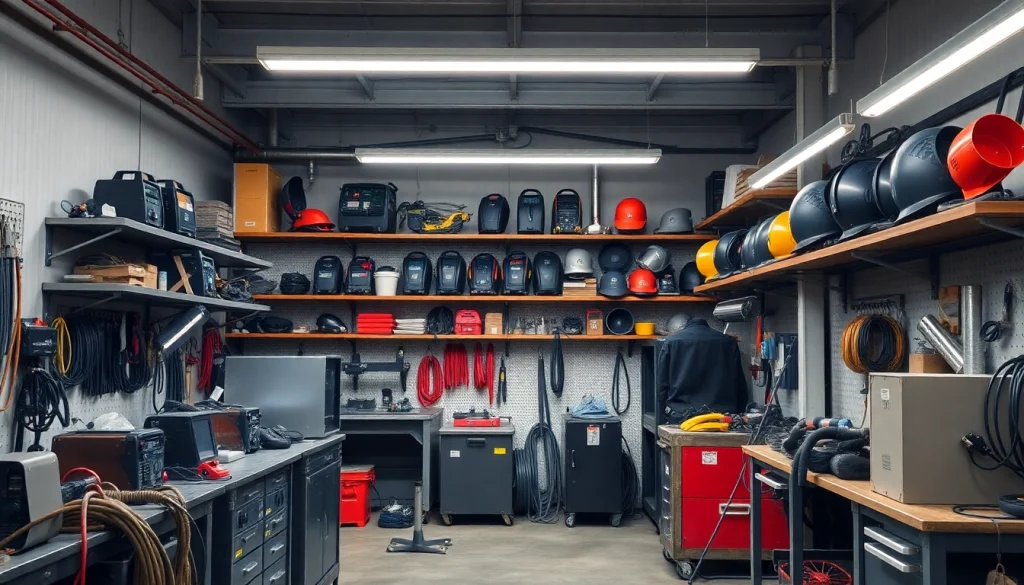Your Comprehensive Guide to Quality Welding Supplies for Every Welder

1. Understanding the Different Types of Welding Supplies
When it comes to welding, understanding the varying types of welding supplies is fundamental. The right equipment can significantly impact the quality and efficiency of your work, whether you’re a professional welder or a DIY enthusiast. This section will explore essential welding equipment, discuss the various welding processes, and introduce key accessories to enhance your welding projects.
1.1 Essential Welding Equipment
The foundation of any welding operation starts with the essential tools, each designed for specific functions within the welding process. Here are some of the critical equipment pieces:
- Welding Machine: The heart of the welding setup, machines can vary from MIG, TIG to Stick welders, each catering to different types of welding styles and materials.
- Welding Helmets: Necessary for protection against harmful rays and sparks, helmets come equipped with a darkening feature that activates during the welding process.
- Welding Gloves: Designed to protect hands from heat, sparks, and electrical shock, these gloves allow for a better grip while manipulating welding tools.
- Welding Jackets: Made from flame-resistant material, jacket protectors are crucial in guarding against burns and injuries.
- Fume Extractors: Essential for maintaining a clean breathing environment, these devices help remove harmful fumes created during welding.
1.2 Types of Welding Processes and Their Supplies
Each welding method employs various techniques and materials altering the supplies needed. Here’s a breakdown of common welding processes:
MIG Welding
MIG, or Metal Inert Gas, welding uses a continuous wire feed as an electrode to create welds. Supplies include:
- Gas cylinders (usually Argon or CO2)
- MIG wire
- Contact tips
TIG Welding
In Tungsten Inert Gas (TIG) welding, a tungsten electrode creates the weld with a filler rod added by hand. Supplies needed are:
- Filler rods specific to the material being welded
- AC/DC TIG welder
- Protective cover gas (Argon)
Stick Welding
Also known as Shielded Metal Arc Welding (SMAW), stick welding uses an electrode rod that melts and fuses the materials. Key supplies for stick welding include:
- Electrode rods for specific materials
- Electrode holder and hood
1.3 Key Accessories for More Efficient Welding
Beyond the primary equipment, having the right accessories can greatly enhance the welding experience:
- Welding Magnets: These help hold metal pieces in place while welding, ensuring better accuracy and stability.
- Welding Clamps: They secure joints together firmly and minimize movement during the welding process.
- Chipping Hammers: Used to remove slag from the weld after it has solidified, presenting a clean finish.
2. Choosing High-Quality Welding Supplies
Selecting high-quality welding supplies is crucial for achieving safe and effective results. With numerous brands and products on the market, it’s essential to recognize the characteristics and factors that define quality.
2.1 Recognizing Trusted Brands in Welding
Trustworthy brands stand out due to their solid reputations and commitment to producing durable materials. Some renowned brands in the welding industry include:
- Miller Electric: Known for high-quality welding machines and welding consumables.
- Lincoln Electric: Offers a wide variety of welding tools, including MIG, TIG, and Stick welders.
- ESAB: Recognized for its innovative welding equipment and cutting technologies.
- Hobart: Provides reliable welding supplies for both professionals and beginners.
2.2 Factors to Consider When Purchasing Welding Supplies
The investment in welding supplies should consider several critical factors including:
- Durability: Ensure equipment is made to withstand frequent use and harsh working conditions.
- Compatibility: Confirm that all welding supplies are compatible with the chosen welding machine.
- Performance: Look for specifications that indicate efficiency in performance such as duty cycle and output range.
- Safety Features: Equipment should comply with safety regulations and offer features that enhance user protection.
2.3 Comparing Prices and Finding Deals on Welding Equipment
Finding the best deals on welding supplies doesn’t mean compromising quality. Here are tips for smart shopping:
- Online Retailers: Compare prices on various e-commerce platforms or manufacturer websites.
- Seasonal Sales: Take advantage of holiday sales or events dedicated to the welding industry.
- Bulk Purchases: Buying in bulk can result in significant savings, especially for frequently used items.
3. Safety First: Essential Gear for Welders
Safety in welding cannot be overstated. The right personal protective equipment (PPE) is essential for minimizing injuries and hazards.
3.1 Importance of Personal Protective Equipment (PPE)
PPE is crucial in establishing a safe welding environment. The primary roles of PPE include:
- Preventing Burns: With exposure to high temperatures, the right clothing can minimize burn risks.
- Shielding from Fumes: Respirators and masks are essential for minimizing the inhalation of dangerous gases.
- Protecting Eyes: Welding helmets offer eye protection against bright light and UV radiation.
3.2 Tips for Selecting the Right Safety Supplies
Choosing the appropriate safety gear can be overwhelming. To simplify the process:
- Assess the Environment: Understand the specific risks associated with the welding project.
- Check for Certification: Ensure that all safety gear complies with standards set by organizations like ANSI and OSHA.
- Fit Matters: Properly fitted gear ensures better protection and comfort during work.
3.3 Maintaining Your Safety Gear for Longevity
To maximize the lifespan of your safety gear:
- Regular Inspections: Check for any signs of wear or damage before each use.
- Proper Cleaning: Follow cleaning procedures specified by manufacturers to prevent deterioration.
- Replace When Necessary: If safety gear is damaged, replace it immediately to avoid risks.
4. Where to Find the Best Welding Supplies
Knowing where to source welding supplies efficiently can save both time and money. This section will compare online and local suppliers, identify top websites for welding supplies, and provide tips for assessing supplier reliability.
4.1 Online vs. Local Suppliers: Pros and Cons
Both online and local suppliers have advantages and disadvantages:
- Online Suppliers:
- Pros: Wider selection, competitive pricing, and often better deals.
- Cons: Delivery time and potential shipping fees.
- Local Suppliers:
- Pros: Immediate purchases, ease of returns, and no shipping costs.
- Cons: Limited selection and often higher prices.
4.2 Top Websites for Purchasing Welding Supplies Online
Here are some reputable websites where you can find a variety of welding supplies:
- Cyberweld – Comprehensive selection of welding supplies.
- Welding Supplies from IOC – Offers a wide array of welding equipment and resources.
- WeldingOutfitter – Trusted supplier with a vast variety of welding materials.
- Welding Supply – Known for high-quality brands and efficient service.
4.3 Tips for Assessing Supplier Reliability
Before committing to a supplier, consider these assessment criteria:
- Read Reviews: Check customer reviews to gauge trustworthiness.
- Return Policy: Ensure they have a fair return and exchange policy.
- Customer Service: Reliable suppliers should offer responsive customer support.
5. Maximizing the Use of Your Welding Supplies
To truly benefit from your welding supplies, it’s necessary to utilize them fully. This section will provide maintenance tips, troubleshoot common issues, and offer training resources.
5.1 Maintenance Tips for Welding Equipment
Maintaining welding equipment is essential for efficiency and longevity:
- Regular Cleaning: Dust and debris should be cleared to maintain performance.
- Scheduled Inspections: Check all components, including cables and connections, for wear.
- Proper Storage: Store equipment in a dry, clean place to avoid damage.
5.2 Common Issues and Troubleshooting in Welding Supplies
Being aware of common welding issues can save time and frustration. Some typical problems include:
- Welding Sticking: This may be due to incorrect settings; adjust voltage and wire feed speed.
- Poor Arc Stability: Check for contaminated or damaged electrodes to restore stability.
- Inconsistent Welds: Ensure the material is clean and free from oil and rust, which can affect weld quality.
5.3 Training and Resources for Better Utilization of Supplies
To enhance your welding skills, consider seeking further training and resources:
- Certification Courses: Various schools and organizations offer certification in welding techniques.
- Online Tutorials: Platforms like YouTube have various tutorials for quick learning tips and tricks.
- Industry Publications: Subscribe to welding magazines and journals to stay updated on the latest techniques and equipment.







